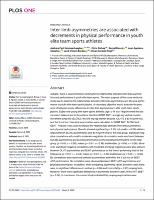Por favor, use este identificador para citar o enlazar este ítem:
https://repositorio.usj.es/handle/123456789/519
| Título : | Inter-limb asymmetries are associated with decrements in physical performance in youth elite team sports athletes |
| Autor: | Fort-Vanmeerhaeghe, Azahara


Bishop, Chris 

Busca Safont-Tria, Bernat 
Aguilera-Castells, Joan 
Vicens-Bordas, Jordi 

Gonzalo-Skok, Óliver 

|
| Palabras clave : | Lower-extremity injury; Excursion balance test; Strength asymmetry; Reliability; Deficits; Sprint; Tests; Leg; Ability; Single |
| Fecha de publicación: | 3-mar-2020 |
| Editorial : | Public Library Science |
| Citación : | Fort-Vanmeerhaeghe A, Bishop C, Buscà B, Aguilera-Castells J, Vicens-Bordas J, Gonzalo-Skok O (2020) Inter-limb asymmetries are associated with decrements in physical performance in youth elite team sports athletes. PLoS ONE 15(3): e0229440. https://doi.org/10.1371/journal.pone.0229440 |
| Resumen : | Actually, there is scarce literature looking for the relationship between inter-limb asymmetries and performance in youth elite team sports. The main purpose of this cross-sectional study was to examine the relationships between inter-limb asymmetries and physical performance in youth elite team-sports players. A secondary objective was to evaluate the presence of between-sexes differences in inter-limb asymmetries in elite youth team sports players. Eighty-one young elite team-sports athletes (age: u-14 to u-18) performed the star excursion balance test in the anterior direction (SEBT ANT), a single leg vertical countermovement jump test (SLCMJ), the one leg hop test for distance (OLHT), a 30 m sprint test, and the V-cut test. Inter-limb asymmetries were calculated for SEBT ANT, SLCMJ and OLHT. Pearson r was used to analyse the relationships between inter-limb asymmetries and physical performance. Results showed significant (p < 0.05) but small (r = 0.26) relationships between SLCMJ asymmetries and 30 m sprint time for the total group. Significant negative correlations with small to moderate magnitude of correlation were also found between SLCMJ asymmetries and SLCMJ performance on the lowest performing limb for the total group (p < 0.05; r = -0.26), males (p < 0.01; r = -0.48) and females (p < 0.05; r = -0.30). Moreover, significant negative correlations with moderate and large magnitude were also present between OLHT asymmetries and OLHT performance on the lowest performing limb for the total group (p < 0.01; r = -0.44), males (p < 0.01; r = -0.56) and females (p < 0.01; r = -0.64). No correlations were observed between asymmetries and either the V-cut test or SEBT ANT performance. No correlation were observed between SEBT ANT asymmetries and physical performance. In addition, when comparing asymmetry values between sexes there were no significant differences in vertical (p = 0.06) and horizontal (p = 0.61) jumping tests. However, there were significant differences in asymmetry between sexes in the ANT SEBT (p = 0.04). In conclusion, the current study indicated that jumping asymmetries were associated with decrements in sprint speed and jumping performance. Therefore, assessing inter-limb asymmetries would be recommended to improve training interventions for youth elite team-sports athletes. |
| URI : | https://repositorio.usj.es/handle/123456789/519 |
| ISSN : | 1932-6203 |
| Aparece en las colecciones: | Artículos de revistas |
Ficheros en este ítem:
| Fichero | Descripción | Tamaño | Formato | |
|---|---|---|---|---|
| Inter-limb asymmetries are associated with decrements in physical performance in youth elite team sports athletes.pdf | 660,27 kB | Adobe PDF |  Visualizar/Abrir |
Este ítem está sujeto a una licencia Creative Commons Licencia Creative Commons

